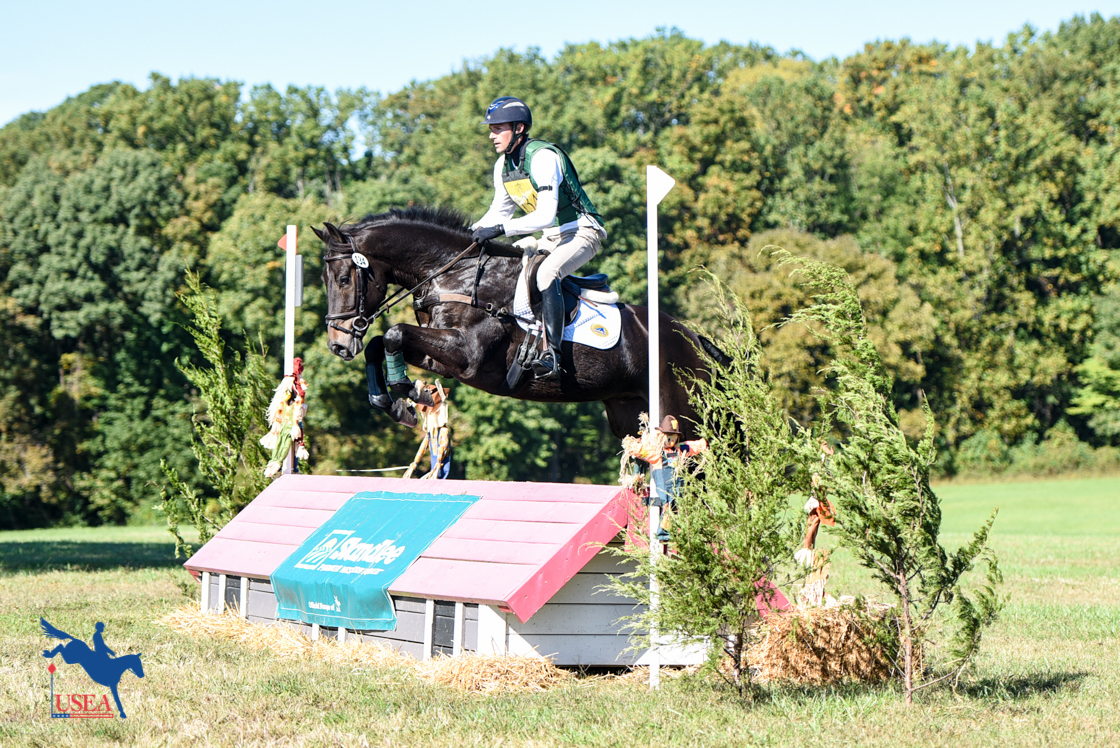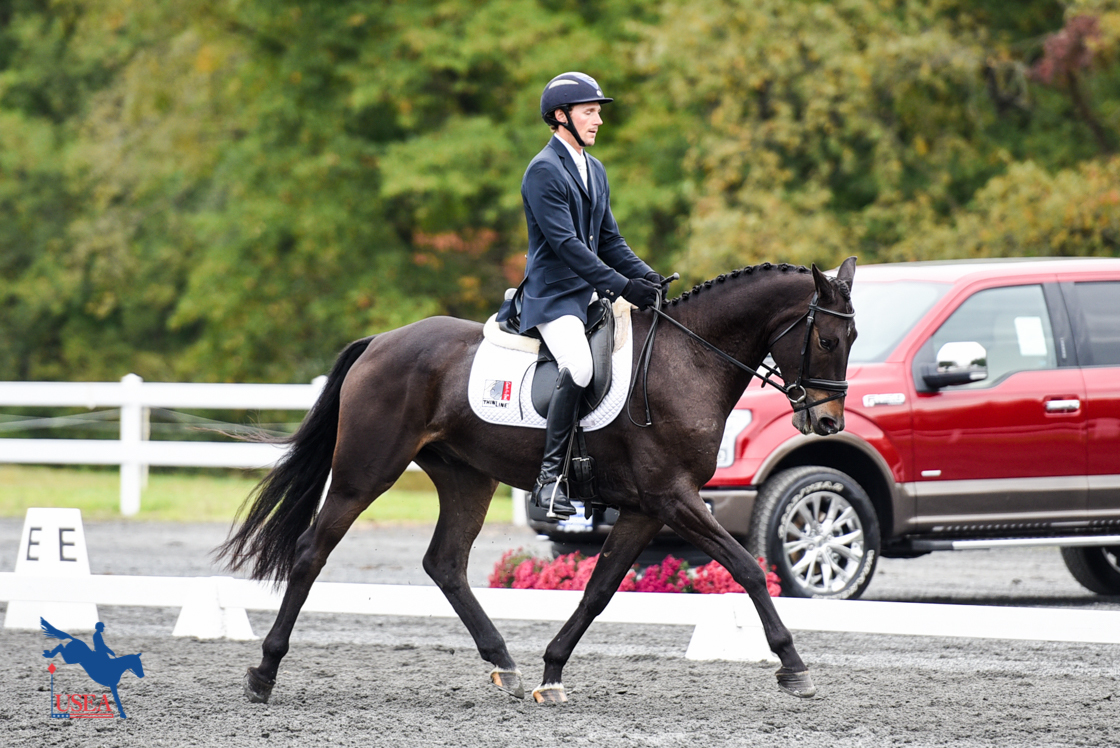Riding the Perfect Warm-up with Clasing Equestrian

“You can’t do well in the ring without a good warm-up,” said Daniel Clasing. “A good warm-up sets the tone for the competition,” Kaitlin Clasing added. Together the two make up Clasing Equestrian based out of Hermitage Farm in Kennett Square, Pennsylvania. The warm-up is where riders spend the most time in the tack during an event. With a mixture of nervous horses, riders, parents, and coaches, the warm-up area can be chaotic. Whether it’s a horse’s first recognized horse trial or at a USEA Young Event Horse (YEH) competition, the Clasings’ have found a tried-and-true warm-up routine for young horses.
“For dressage I often try to include a free walk, keeping the frame down and forward rather than getting distracted and looking around. Once they’re swinging across their topline taking the contact down, I would then put them on the bit and make sure they’re steady in each gait and through transitions. In the jumping I want them in front of the leg and ridable, making sure they can go forward and back in the canter. Once the canter is good, I make sure they are comfortable jumping the cross rail, vertical, and oxer at competition height,” explained Daniel.
The Clasings have competed over 15 different horses in the YEH program and have taken numerous horses to their first recognized horse trials including Shelby Brost’s Crimson, winner of 2016 North American Young Rider Championships CIC2*, and Herringswell Stables Ltd’s Sea of Clouds, who currently competes at the Intermediate level with Phillip Dutton. Introducing eventing to horses also comes the introduction of warm-up, and “With young horses it’s not so much about loosening them up and working on movements as [it’s more about] installing the buttons you need to get through the competition,” said Kaitlin.

In order to make sure the buttons are properly installed, Daniel Clasing allows for 30 minutes of warm-up. “I’ll aim for thirty minutes with the young horses. You spend a certain amount of time preparing, but if we’ve done our homework it shouldn’t take longer than that. Before they get to a competition they will be well schooled at home, have gone cross-country schooling, and done several low-key schooling competitions. If it takes longer than 30 minutes to get them settled, they probably aren’t ready for a recognized event.”
Every horse and every rider has a different approach, and Kaitlin’s is focused on the leg-to-hand connection. “[Warm-up] stays pretty much the same for each phase. It’s my job to get them to a place where they’re in front of my leg and accepting my hand. For the one-day events I’d let the warm-ups build on each other. When we get on to show jump, we don’t need to go through the whole flat warm-up again, just make sure they’re happy jumping. For a hotter young horse, I might finish by trotting a jump to get them to settle. When we get to cross-country, they’ve already jumped a bit. I want to let them see solid fences if that’s available in the warm-up and most importantly I want to make sure they will move off comfortably away from the warm-up and other horses. I’d have a little canter around the warm-up, sending them forward and back as we go away from the trailers and other horses.”
The leg-to-hand connection is one way to help nervous, skittish, or claustrophobic horses in warm-up. “In general, the more connected and correctly a horse is going the less they will notice other horses. If I have one that I know is skittish I will start their warm-up away from the other horses. Once they are going correctly, I’ll move them over to the main warm-up.” Daniel continued, “I would try to find the quietest area of the warm-up and do what I can to keep them moving forward from the leg. Sometimes this requires doing some smaller circles or frequent transitions to walk so you don’t end up riding too much on your hand.”

The Clasings’ additional tips for nervous horses emphasize the preparation prior to an event. “Try to build the horse’s experience up through schooling outings so that they’re relatively calm by the time they get to a proper competition. Sometimes we’ll put them on the trailer to hang out while other horses are competing so they get used to relaxing in a show atmosphere,” said Daniel. “Before we go to a competition, we want to make sure they’ve been exposed to a busy atmosphere. We’re lucky that our barn is busy enough they will have opportunities to go in the ring with other horses. We may stay on them to teach a lesson or do a jump school with multiple horses in the ring, so they get very comfortable with other horses working around them,” said Kaitlin.
With years of experience introducing all types of horses to the sport of eventing, the Clasings’ have learned how to take advantage of a competition warm-up. After all, a good warm-up is vital to the success in the ring.

About the USEA Young Event Horse Program
The Young Event Horse (YEH) Program was first established in 2004 as an eventing talent search. Much like similar programs in Europe, the YEH program was designed to identify young horses that possess the talent and disposition to, with proper training, excel at the uppermost levels of the sport. The ultimate goal of the program is to distinguish horses with the potential to compete at the four- and five-star levels, but many fine horses that excel at the lower levels are also showcased by the program.
The YEH program provides an opportunity for breeders and owners to exhibit the potential of their young horses while encouraging the breeding and development of top event horses for the future. The program rewards horses who are educated and prepared in a correct and progressive manner. At qualifying events, youngsters complete a dressage test and a jumping/galloping/general impression phase. At Championships, young horses are also evaluated on their conformation in addition to the dressage test and jumping/galloping/general impression phase. Click here to learn more about the Young Event Horse Program.
The USEA would like to thank SmartPak, Standlee Hay Company, Merck Animal Health, and C4 Belts for sponsoring the Young Event Horse Program.














